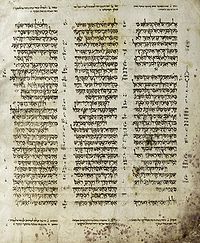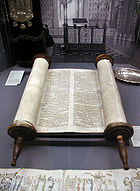- Book of Nehemiah
-
Part of a series on The Hebrew Bible
and DeuterocanonGenesis · Exodus · Leviticus · Numbers
Deuteronomy · Joshua · Judges · Ruth
1–2 Samuel · 1–2 Kings · 1–2 Chronicles
Ezra · Nehemiah · Esther · Job · Psalms
Proverbs · Ecclesiastes · Song of Songs
Isaiah · Jeremiah · Lamentations
Ezekiel · Daniel · Minor prophetsTobit · Judith · 1–2 Maccabees
Wisdom (of Solomon) · Sirach
Baruch · Letter of Jeremiah
Additions to Daniel / to Esther Bible portal
Bible portalThe Book of Nehemiah is a book of the Hebrew Bible. Told largely in the form of a first-person memoir, it concerns the rebuilding of the walls of Jerusalem by Nehemiah, a Jew who is a high official at the Persian court, and the dedication of the city and its people to God's laws (torah). The events take place in the second half of the 5th century BCE, and together with the Book of Ezra, it represents the final chapter in the historical narrative of the Hebrew bible[1]
The original core of the book, the first-person memoir, may have been combined with the core of the Book of Ezra around 400 BCE. Sceptics also argue that further editing continued into the Hellenistic era[citation needed], but this view is debated[citation needed].
The book tells how Nehemiah, at the court of the king in Susa, is informed that Jerusalem is without walls and resolves to restore them. The king appoints him as governor of Judah and he travels to Jerusalem. There he rebuilds the walls, despite the opposition of Israel's enemies, and reforms the community in conformity with the law of Moses. After an absence in Susa he returns to find that the Israelites have been backsliding, taking non-Jewish wives, and stays to enforce the Law.
Contents
Summary
For the bible text see Bible Gateway (opens at NIV version)
The book has 13 chapters, mostly in the first person -- these passages are called the Nehemiah Memorandum. It also includes numerous lists, but unlike the Book of Ezra it contains no quoted documents.
- 1. In the 20th year of Artaxerxes (the king of Persia), Nehemiah, cup-bearer to the king in Susa (the Persian capital), learns that the wall of Jerusalem is destroyed. He prays to God, recalling the sins of Israel and God's promise of restoration in the land, and asks Artaxerxes for leave to return to Jerusalem and rebuild its walls; the king is receptive and extends aid to his mission.
- 2. Nehemiah returns to Jerusalem, carrying letters of authorisation from the king; he inspects the walls.
- 3. Nehemiah and the Jews (including the 'High Priest' Eliashib), begin rebuilding Jerusalem.
- 4. The enemies of the Jews - Sanballat of Samaria, Tobiah the Ammonite, Geshem the Arab, and the men of Ashdod - plot to attack Jerusalem, and the Jews work with weapons in their hands.
- 5. Nehemiah sees that the Jewish nobles are oppressing the poor, and forces the cancellation of all debt and mortgages; while previous governors have been corrupt and oppressive, he has been righteous and just.
- 6. Sanballat accuses Nehemiah of planning rebellion against Artaxerxes, and he is opposed even by Jewish nobles and prophets, but the wall is completed.
- 7. Nehemiah appoints officials and sets guards on the wall and gates; he plans to register the Jews, and finds the Census of those who had returned earlier.
- 8. Nehemiah assembles the people and has Ezra read to them the law-book of Moses; Nehemiah, Ezra and the Levites institute the Feast of Booths, in accordance with the Law.
- 9. The Jews assemble in penance and prayer, recalling their past sins, God's help to them, and his promise of the land.
- 10. The priests, Levites and people enter into a covenant, agreeing to separate themselves from the surrounding peoples and to keep the Law.
- 11. Jerusalem is repopulated from the Jews living in the towns and villages of Judah and Benjamin.
- 12. A list of priests and Levites who returned in the days of Cyrus (the first returnees from Babylon); Nehemiah, aided by Ezra, oversees the dedication of the walls and rebuilt city.
- 13. After 12 years Nehemiah returns to Susa; he later comes back to Jerusalem, and finds that there has been backsliding in his absence. He takes measures to enforce his earlier reforms and asks for God's favour.
Historical background
The book is set in the 5th century. Judah is one of several provinces within the larger satrapy (a large administrative unit) within the Persian empire. The capital of the empire is at Susa. Nehemiah is a cup-bearer to king Artaxerxes II - an important official position.
At his own request Nehemiah is sent to Jerusalem as governor of Yehud, the official Persian name for Judah. Jerusalem had been conquered and destroyed by the Babylonians in 586 BCE, and Nehemiah finds it still in ruins. His task is to rebuild the walls and to re-populate the city. He faces opposition from three powerful neighbours, the Samaritans, the Ammonites, and the Arabs, as well as the city of Ashdod, but manages to rebuild the walls. He then purifies the Jewish community by enforcing its segregation from its neighbours and enforces the laws of Moses.
Textual history
Further information: Ezra-NehemiahEzra-Nehemiah, grouped as a single book with the title "Ezra", was accepted into the canon of scripture around the middle of the 2nd century BCE, when it was translated into Greek.[2] They were first divided into separate books by the early Christian scholar Origen, in the 3rd century CE, and the separation became entrenched in the 5th century CE when it was followed by Jerome in his Latin translation of the Bible.[3] It was not until the Middle Ages that the separation was introduced into Jewish Bibles.[4]
Composition and date
The combined book Ezra-Nehemiah of the earliest Christian and Jewish period was known as Ezra and was probably attributed to him; according to a rabbinic tradition, however, Nehemiah was the real author but was forbidden to claim authorship because of his bad habit of disparaging others.[5]
The Nehemiah Memorial, chapters 1-7 and 11-13, may have circulated as an independent work before being combined with the Ezra material to form Ezra-Nehemiah.[6] Determining the composition of the Memorial depends on the dates of Nehemiah's mission: It is commonly accepted that "Artaxerxes" was Artaxerxes I (there were two later kings of the same name), and that Nehemiah's first period in Jerusalem was therefore 445-433 BCE;[7] allowing for his return to Susa and second journey to Jerusalem, the end of the 5th century BCE is therefore the earliest possible date for the Memorial.[8] The Nehemiah Memorial is interrupted by chapters 8-10, which concern Ezra. These have sometimes been identified as another, separate work, the Ezra Memorial (EM), but other scholars believe the EM to be fictional and heavily altered by later editors. Both the Nehemiah and Ezra material are combined with numerous lists, Censuses and other material.
The first edition of the combined Ezra-Nehemiah may date from the early 4th century;[9] further editing continued well into the following centuries.
References
Books of the
Ketuvim (Hebrew Bible)Three poetic books Psalms
Proverbs
JobFive Megillot Song of Songs
Ruth
Lamentations
Ecclesiastes
EstherOther books Daniel
Ezra – Nehemiah
Chronicles- ^ Albright, William (1963). The Biblical Period from Abraham to Ezra: An Historical Survey. Harpercollins College Div. ISBN 0061301027. http://www.amazon.com/Biblical-Period-Abraham-Ezra-Historical/dp/0061301027.
- ^ Graham, M.P, and McKenzie, Steven L., "The Hebrew Bible today: an introduction to critical issues" (Westminster John Knox Press, 1998) p.202
- ^ Fensham, F. Charles, "The books of Ezra and Nehemiah" (Eerdmans, 1982) p.1
- ^ Dillard, Raymond B., and Longman, Tremper, "An introduction to the Old Testament" (Zondervan) p.180
- ^ Blenkinsopp, Joseph, "Judaism, the first phase" (Eerdmans, 2009) p.86
- ^ La Sor, W.S., William Sanford La Sor, Hubbard, D.A., Bush, F.W., "Old Testament survey: the message, form, and background of the Old Testament" (Eerdmans, 1996) p.551
- ^ Graham, M.P, and McKenzie, Steven L., "The Hebrew Bible today: an introduction to critical issues" (Westminster John Knox Press, 1998) p.205
- ^ Graham, M.P, and McKenzie, Steven L., "The Hebrew Bible today: an introduction to critical issues" (Westminster John Knox Press, 1998) p.213
- ^ La Sor, W.S., William Sanford La Sor, Hubbard, D.A., Bush, F.W., "Old Testament survey: the message, form, and background of the Old Testament" (Eerdmans, 1996) p.551
External links
- Commentaries
- Blenkinsopp, Joseph, "Ezra-Nehemiah: A Commentary" (Eerdmans, 1988)
- Coggins, R.J., "The Books of Ezra and Nehemiah" (Cambridge University Press, 1976)
- Fensham, F. Charles, "The books of Ezra and Nehemiah" (Eerdmans, 1982)
- Grabbe, L.L., "Ezra-Nehemiah" (Routledge, 1998)
- Throntveit, Mark A., "Ezra-Nehemiah" (John Knox Press, 1992)
- Other
- Clements, R.E. (ed), "The World of Ancient Israel" (Cambridge University Press, 1989)
- Blenkinsopp, Joseph, "Judaism, the first phase" (Eerdmans, 2009)
- Garbini, G., "Myth and history in the bible" (Sheffield Academic Press, 2003)
- Grabbe, L.L., "A history of the Jews and Judaism in the Second Temple Period, Volume 1" (T&T Clark, 2004)
- Graham, M.P, and McKenzie, Steven L., "The Hebrew Bible today: an introduction to critical issues" (Westminster John Knox Press, 1998)
- Pakkala, Juha, "Ezra the scribe: the development of Ezra 7-10 and Nehemiah 8" (Walter de Gryter, 2004)
- Translations
Book of NehemiahPreceded by
EzraHebrew Bible Succeeded by
ChroniclesProtestant
Old TestamentSucceeded by
EstherRoman Catholic
Old TestamentSucceeded by
TobitEastern Orthodox
Old TestamentBooks of the Bible Principal divisions Orthodox- Enoch
- Jubilees
- 1-3 Meqabyan
- Paralipomena of Baruch
Subdivisions Development Manuscripts See also Categories:
Wikimedia Foundation. 2010.


